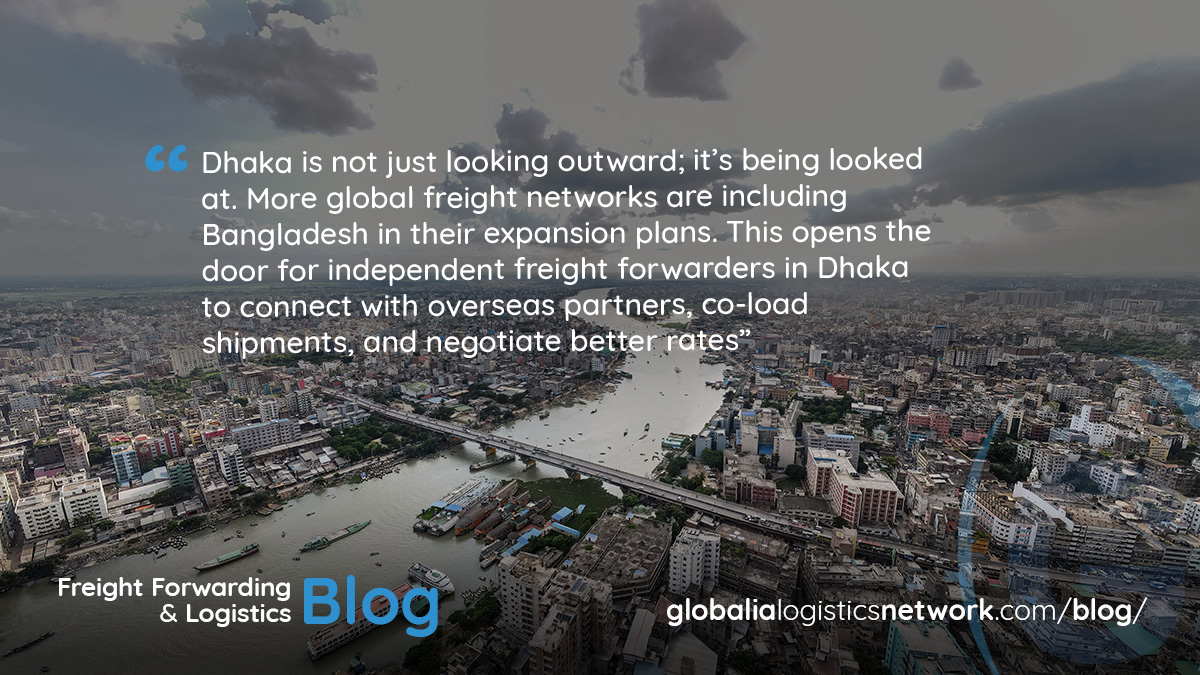Dhaka, the economic heartbeat of Bangladesh, is one of the most densely populated and fast-growing cities in South Asia. With a GDP consistently above 6 percent over the past decade and exports crossing $50 billion in recent years, the logistics industry in Dhaka isn’t just growing , it’s becoming a central piece of the city’s infrastructure puzzle.
Let’s break down why logistics in Dhaka matters, where the industry is heading, and what opportunities are emerging for freight forwarders and logistics players on the ground.
A growing export economy needs smarter logistics
Bangladesh’s economy, particularly its massive textile and garment sector, relies heavily on international trade. Dhaka, being the commercial core, handles the lion’s share of this movement. The city is home to hundreds of manufacturers and exporters, with most shipments eventually moving through the Chittagong Port.
Here’s the problem: outdated infrastructure, traffic bottlenecks, and poor coordination between logistics providers have traditionally held things back. But that’s changing. The government is pushing ahead with multimodal connectivity plans — including highway expansions, inland container depots, and rail freight links — to relieve the pressure. At the same time, private logistics companies are investing in technology and warehousing to streamline operations.

Key growth drivers
1. Rise of e-commerce and urban logistics
Bangladesh’s e-commerce market has exploded, especially post-COVID. In Dhaka alone, millions of deliveries are being made monthly. This has created demand for last-mile delivery networks, micro-fulfillment centers, and smarter fleet management. Local startups and regional giants are fighting for market share, driving innovation in urban logistics. This trend isn’t slowing down anytime soon.
2. Infrastructure upgrades
Mega projects like the Padma Bridge, Dhaka Elevated Expressway, and the upcoming Dhaka Bypass are set to reduce transport time significantly. Meanwhile, the construction of Inland Container Depots (ICDs) like the Pangaon terminal and others near Dhaka means goods can be consolidated and cleared closer to origin points. These changes are laying the groundwork for a more agile and distributed logistics ecosystem.
3. Policy and trade facilitation
Bangladesh’s National Logistics Policy (under development) and its long-term export strategy are placing a fresh emphasis on improving supply chain efficiency. Customs procedures are being digitized. Bonded warehouse rules are under review to make trade more competitive. International organizations like the World Bank and JICA are working alongside local stakeholders to boost logistics capacity, especially in Dhaka and its surrounding economic zones.
What’s happening on the ground: warehousing, 3PLs, and tech
Dhaka is seeing increased activity in third-party logistics (3PL) services. Global freight companies and domestic players are expanding warehouse space, adopting WMS (warehouse management systems), and building cold chain capabilities — especially for food, pharma, and fast-moving consumer goods.
For freight forwarders, this is a critical opportunity. Exporters in Dhaka are looking for partners who can offer end-to-end logistics — including customs clearance, storage, transport, and visibility — at a competitive price. Digital platforms that provide real-time tracking, route optimization, and data analytics are gaining traction. This is creating demand for more specialized services and skill sets, pushing the industry toward better service standards.
Challenges to watch out for
Despite the momentum, Dhaka’s logistics sector isn’t without its hurdles.
1. Urban congestion
Dhaka’s infamous traffic slows down delivery times, increases fuel costs, and complicates scheduling. While infrastructure upgrades are on the way, current congestion levels remain a major concern.
2. Fragmented market
A large portion of the industry is still informal, with many small operators lacking standardized pricing or digital tools. This fragmentation can create inefficiencies, especially for larger freight forwarding operations.
3. Skills gap
As the sector evolves, there’s a growing need for trained professionals who understand international logistics, supply chain technology, and compliance. Addressing this talent gap will be crucial for sustaining growth.
Emerging opportunities for freight forwarders
Freight forwarders looking to expand in Dhaka should keep an eye on three main areas:
1. Consolidation and cross-docking
As cargo volumes grow, the need for consolidation services is rising. Freight forwarders who can offer smart cross-docking or LCL (less-than-container load) services will have a strong advantage, particularly in Dhaka’s industrial zones.
2. Regional connectivity
With improved rail and road links connecting Dhaka to India, Nepal, and Bhutan, regional trade corridors are opening up. This creates opportunities for multimodal freight services and cross-border logistics partnerships.
3. Tech-driven visibility
Shippers in Dhaka are increasingly demanding better tracking and performance insights. Freight forwarders who can integrate digital solutions whether via apps, dashboards, or APIs can differentiate themselves quickly.
Why joining an international network like Globalia matters
Dhaka is no longer just a local logistics hub—it’s part of a fast-evolving global trade map. But for independent freight forwarders, staying competitive in this landscape means going beyond borders. The reality is, without strong international partnerships, it’s almost impossible to keep up with the multinationals.
That’s where Globalia Logistics Network makes a real difference. First, Globalia offers market exclusivity. Once you join, you’re the only freight forwarder from Dhaka within the network. That means all shipments to and from your territory go through you, giving you a clear advantage and more business opportunities.
But exclusivity is just the beginning. Globalia also provides access to FreightViewer, a cutting-edge digital quoting platform that allows you to send instant freight quotes to partners around the world. It’s the kind of digital capability global clients expect—and most independent forwarders lack. Then there’s the Annual Meeting, a chance to meet face-to-face with 100+ trusted partners from across the network. In just a few days, you can build the kind of relationships that would normally take years to develop. It’s where collaboration begins and long-term partnerships are sealed.
In short, Globalia gives you the tools, connections, and visibility you need to compete—not as a small local player, but as a truly global logistics provider. If you’re a freight forwarder in Dhaka aiming to expand your business, boost credibility, and stand toe-to-toe with multinational competitors, joining Globalia isn’t just a smart move. It’s essential.
Join us before the spot is taken!
Final thoughts: Dhaka is ready for logistics 2.0
Dhaka’s logistics industry is no longer an afterthought in South Asian trade. It’s becoming a vital engine that drives exports, powers e-commerce, and supports regional supply chains. Yes, the city’s roads are still jammed and bureaucracy still exists. But the direction is clear: Dhaka is investing, digitizing, and connecting. For freight forwarders, 3PL providers, and logistics startups, this is the time to get in to build relationships, upgrade services, and lock in long-term growth in one of South Asia’s most dynamic markets.


